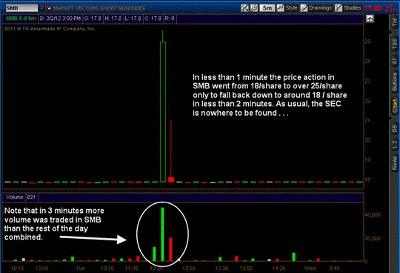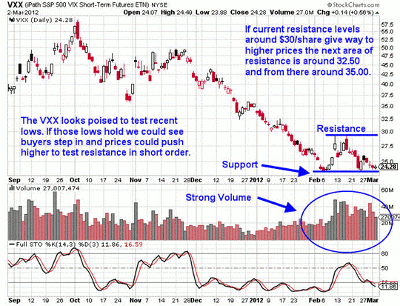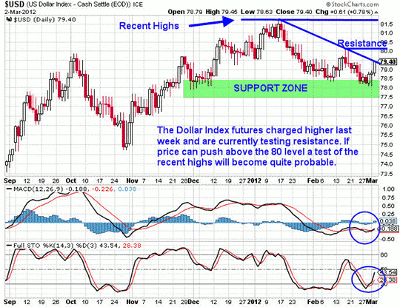Last week’s rally pushed the US dollar index near a key resistance level, and a breakthrough would likely lead to a new test of recent highs, impacting equity, commodity, and bond markets in the process.
The past few months have been a difficult environment for anyone who was bearish. The next few months may prove to be difficult for everyone regardless of directional bias.
We live in a world where headlines can move the market in split seconds, as high-frequency trading robots cause flash rallies and flash crashes regularly.
Before we turn our attention to the US dollar, let’s look at the munis. As an example, the price action in the Market Vectors Short Muni Index (SMB) on February 28 demonstrates the impact that these high-frequency traders have on illiquid underlying assets.
See related: Can Trading Algorithms Infect FX, Too?
We certainly hope there were not any absent-minded retail investors who got caught using market orders during the flash rally only to recognize losses as great as 5% or more in a matter of minutes.
The following chart illustrates a flash rally and the monster 40%-plus rally witnessed in less than one minute. Can someone say fat-finger mistake?
Market Vectors Short Muni Index (SMB) One-Minute Chart
In addition to high-frequency trading, we have to constantly monitor the headlines coming out of Europe, as one event or official statement has the potential to cause the euro to rally or sell off almost instantly whether the information is fact or fiction.
We have traded small for the most part during the beginning of 2012 as market conditions have been volatile even if the Volatility Index (VIX) has not necessarily supported that view.
See related: A VIX Event That Defies Reason
One after another, “perma-bears” have capitulated to the bullish camp and we now have pundits calling for the Dow Jones Industrial Average to move over 15,000 by the end of the year. We both use strategies that in many cases would be considered contrarian by nature. Admittedly, we will not get every move in the market correct, but what we will do is lay out key areas to which price action should migrate across short-, intermediate-, and long-term time frames.
Our objective is to provide readers with actionable information that can be viewed objectively by both bulls and bears alike. With that said, the following viewpoint we have of the marketplace today runs contrary to the collective group of market pundits.
While most market pundits expect higher prices and stronger economic data, there is reason to believe that recent developments could be indicating that volatility may lurk ahead. Volatility could rise up and push equity valuations lower in the near term.
The daily chart of the iPath S&P 500 VIX Short-Term Futures ETF (VXX) shown below illustrates that VXX has seen strong volume in the past few weeks. Additionally, VXX appears to be trying to form a bottom.
With volatility at these levels, put protection is cheap and it would appear based on volume that the smart money is getting long volatility. Long VXX trades are designed to either act as a portfolio hedge or as a potential profit mechanism should a correction play out.
By now most readers are aware of the rally that has been taking place in oil futures for the past few weeks. Nancy Pelosi came out with a statement blaming those evil speculators again, while Republican Presidential hopefuls used higher oil prices as another key political topic against the current administration.
Just when the noise was starting to rise to a roar, the marketplace was quieted by a rally in the US dollar on February 29. The daily chart of the dollar index futures is shown below.
NEXT: Dollar Index Futures Daily Chart
|pagebreak|Dollar Index Futures Daily Chart
Do readers find it rather odd that just about the time when oil was on the lips of every media personality in the United States, the Federal Reserve issued a reverse-repo to pull in liquidity? Do you find it at all coincidental, or could it be that Mr. Bernanke was told to slow down the rally in oil prices?
After the reverse-repo was performed, the dollar soared higher and was showing continuation to the upside on Friday afternoon during intraday trade. The dollar is potentially forming a bottom, and the fact that the Federal Reserve is aiding in that formation presents additional risk for downside in the S&P 500 Index and precious metals in the near term.
For the past several weeks, the US dollar index has pulled back, and the S&P 500 definitely took notice. However, the dollar is on the verge of carving out a weekly swing low, which could give rise to much higher prices.
While many pundits routinely mock the dollar and trash it, in the event of a major currency or credit event in Europe, the dollar will be one of the key safe havens where large sums of wealth will migrate.
If the dollar index futures can push through the downtrend line illustrated on the chart above with strong supporting volume, a much larger move higher will likely play out. Should that scenario play out, the S&P 500 Index will likely begin to roll over.
It should be noted that the S&P 500 has struggled on multiple occasions to break above the key 2011 highs. The S&P 500 index daily chart demonstrates resistance directly above current price action.
Ultimately, we believe the two most critical assets to monitor at this time are the US dollar and oil futures. The US domestic economy cannot handle significantly higher oil prices from the current levels without seeing business growth slow. Furthermore, if the dollar rallies, it could put pressure on the equity markets as well.
While the equity markets and the economy are not the same thing, it is important to note that higher oil prices at a certain point will become equity negative.
The VIX is sending a warning that market participants are too complacent, and the dollar is potentially forming a rounded out bottom. These two conditions paired with geopolitical risk in the Middle East represent additional risks to economic growth.
Furthermore, market participants cannot become complacent regarding the potential risk that Europe still poses. With the various risks listed above in mind, we are keeping position sizes small and are attempting to remain Delta-neutral in our portfolios. Risk is beginning to elevate to extremes.
See related: Delta-Neutral Option Trading
By JW Jones of OptionsTradingSignals.com
























